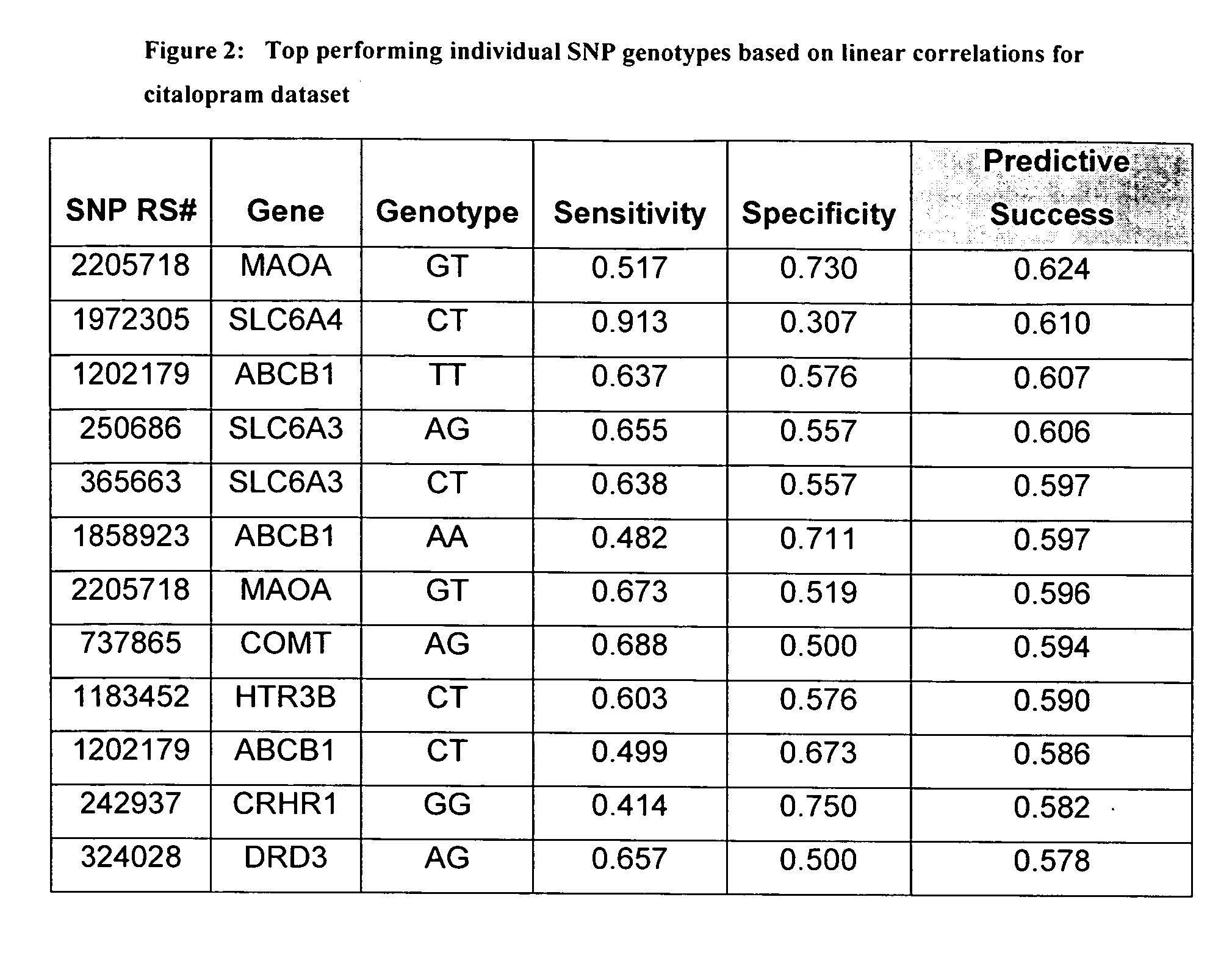Diagnostic markers of depression treatment and methods of use thereof
- Summary
- Abstract
- Description
- Claims
- Application Information
AI Technical Summary
Benefits of technology
Problems solved by technology
Method used
Image
Examples
example 1
A four-week study of 118 severely depressed patients on the molecule citalopram was performed. Severely Depressed patients were defined to have a HAM-D score of 18 or greater. The patients were newly diagnosed and not on any previous psychotropic medication. The molecule citalopram was used in this study.
As an independent measure, a ≧50% decrease in HAM-D score may be considered a response (Lecrubier Y, Clerc G, Didi R, Kieser M. Related Articles, Links Abstract Efficacy of St. John's wort extract WS 5570 in major depression: a double-blind, placebo-controlled trial. Am J Psychiatry. August 2002;159(8):1361-6.). However, we decided that using three different measures of emotional state that were averaged would provide a more reliable assessment of response than the HAM-D test alone.
Therefore, scores from the HAM-D, the Emotional State (Depression Section Only; Dep), and the final (4 week) CGI-I score were used to determine patient response to the treatment with Cital...
example ii
Pharmacogenomics of Paroxetine in Treating Depression
In recent years, the search for a single gene responsible for major depressive disorder has given way to the understanding that multiple gene variants, acting together with yet unknown environmental risk factors or developmental events, interact in a complex system to account for its expression phenotype. In accordance, treatments that successfully alleviate depression symptoms are likely to act on multiple gene products.
A popular hypothesis of the pathophysiology of depression, called the monoamine hypothesis, proposes that the underlying pathophysiologic basis of depression is a depletion in the levels of serotonin, norepinephrine, and / or dopamine in the central nervous system. This is supported by the mechanism of action of antidepressants, which is to elevate the levels of these neurotransmitters in the brain (R. Tissot. The common pathophysiology of monaminergic psychoses: a new hypothesis. Neuropsychobiology ...
example iii
Sequencing of ABCB1, ABCB4, ADRA1A, ADRA1D, ADRA2A, ADRB1, ADRB2, COMT, CRH, CRHBP, CRHR1, CRHR2, CYP2D6, CYP3A4, CYP2D19, DRD1, DRD2, DRD3, DRD4, GLRF1, HTR1A, HTR1B, HTR1D, and / HTR2A, HTR2B, HTR2C, HTR3A, HTR3B, MAOA, MAOB, NR3C1, SLC6A2 SLC6A3, SLC6A4, TAC1, TACR1 or TPH Genes
Plasmid DNA containing the ABCB1, ABCB4, ADRA1A, ADRA1D, ADRA2A, ADRB1, ADRB2, COMT, CRH, CRHBP, CRHR1, CRHR2, CYP2D6, CYP3A4, CYP2D19, DRD1, DRD2, DRD3, DRD4, GLRF1, HTR1A, HTR1B, HTR1D, HTR2A, HTR2B, HTR2C, HTR3A, HTR3B, MAOA, MAOB, NR3C1, SLC6A2 SLC6A3, SLC6A4, TAC1, TACR1 or TPH gene inserts is obtained as described in Example I is isolated using the Plasmid Quik.™. Plasmid Purification Kit (Stratagene, San Diego, Calif.) or the Plasmid Kit (Qiagen, Chatsworth, Calif., Catalog #12145). Plasmid DNA is purified from 50 ml bacterial cultures. For the Stratagene protocol “Procedure for Midi Columns,” steps 10-12 of the kit protocol are replaced with a precipitation step using 2 volumes of 100% ethanol at ...
PUM
| Property | Measurement | Unit |
|---|---|---|
| Electrical resistance | aaaaa | aaaaa |
| Entropy | aaaaa | aaaaa |
Abstract
Description
Claims
Application Information
 Login to View More
Login to View More - R&D
- Intellectual Property
- Life Sciences
- Materials
- Tech Scout
- Unparalleled Data Quality
- Higher Quality Content
- 60% Fewer Hallucinations
Browse by: Latest US Patents, China's latest patents, Technical Efficacy Thesaurus, Application Domain, Technology Topic, Popular Technical Reports.
© 2025 PatSnap. All rights reserved.Legal|Privacy policy|Modern Slavery Act Transparency Statement|Sitemap|About US| Contact US: help@patsnap.com



